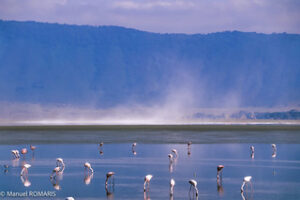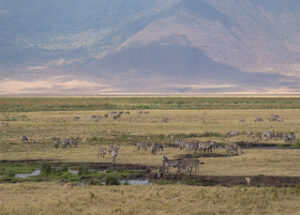Renowned for its stunning scenery, great biodiversity, and rich culture, Ngorongoro National Park is strategically placed well in Tanzania and known as the gem of East Africa. Offering guests a unique chance to see the actual splendor of Africa, this UNESCO World Heritage Site is the real definition of the miracles of nature. Our guide will walk you through the site, activities, attractions, best time to visit, modes of transportation, and lodging choices accessible in Ngorongoro National Park.
Location of Ngorongoro National Park
Ngorongoro National Park lies over 180 kilometers west of Arusha in northern Tanzania. Arusha is the base city for safari excursions in Tanzania generally known as TZ. The park is a component of the greater Ngorongoro Conservation Area, which covers more than 8,000 square kilometers and features many habitats including rich woodlands, unusual grassland, and varied species.
Activities within Ngorongoro National Park
From wildlife drives to cultural encounters, Ngorongoro National Park presents a wide range of activities to fit every tourist’s tastes. Here we explore a few of these pursuits:
Game drive at Ngorongoro National Park
Starting an exhilarating game drive around Ngorongoro Crater, home to a great number of animals including the Big Five (lion, elephant, buffalo, leopard, and rhinoceros), The special environment of the crater supports a wide range of species, including birds and primates, which makes it a perfect spot for natural enthusiasts and observation of wildlife.
Guided walking safaris
These safaris within the park are accessible to individuals looking for a more private safari experience. Supported by seasoned rangers, guests can explore the park on foot, discovering the indigenous flora and animals and gaining understanding of the tiny savannah occupants. Experienced guide will always accompany to provide a further insight on what you need to know about Ngorongoro crater and its environment.
Cultural visits at Ngorongoro National Park
Visit a Masai hamlet to explore the rich cultural legacy of the Maasai people. Participate in cultural interactions, discover age-old customs and practices, and see amazing traditional dances carried out by the Maasai warriors. You will also be able to see Masai people’s dress code and their hand-made shoes (opens).
Birdwatching at Ngorongoro National Park
With around 500 bird species—including flamingos, ostriches, and several birds of prey—Ngorongoro National Park is a paradise for birdwatchers. Guided birding trips allow birdwatchers to find some of the most vivid and elusive avian species found in Africa that call the park home.
Photography safaris
With its breathtaking scenery, animals, birds, water sources, this park is ideal for all kinds of photographers. Come with the ideal camera so you may save some pictures for the future of this amazing journey.
Attractions in the Ngorongoro National Park
Renowned for its famous sights, each providing a different window into the local natural beauties, Ngorongoro National Park Among the park’s must-see attractions are these:
Ngorongoro Crater
Often dubbed the “Eighth Wonder of the World,” the most notable feature of the park is the Ngorongoro Crater. Against stunning surroundings, this volcanic crater hosts an amazing concentration of animals including hippos, lions, and elephants.
Empakaai Crater
Tucked down in the northeastern section of the park, the Empakaai Crater is a hidden treasure just waiting to be discovered. Renowned for its emerald-green lake, which draws flocks of flamingos and other aquatic birds, this peaceful crater provides a stunning backdrop for nature lovers.
Olduvai Gorge
One of the most significant archeological sites in the world, Olduvai Gorge lets one explore the prehistoric past. Many fossilized remains and stone artifacts from this ancient ravine have given important new perspectives on human evolution over millions of years.
Lerai Forest
Found on the crater floor, Lerai Forest is a lush haven among the plains of the savannah. Comprising a range of trees and plants, including acacias and yellow fever trees, this rich forest offers cover and food for a wide range of species, thus perfect for birdwatching and wildlife photography.
Gol Mountains
Rising majestically over the crater’s eastern horizon, the Gol Mountains provide expansive perspective of the surrounding terrain. Trekkers can challenge the difficult paths climbing to the peak, where they will be rewarded with expansive views of the crater below and the huge Serengeti grasslands beyond.
Optimal Visit Time at Ngorongoro National Park
Your tastes and interests will mostly determine when would be the ideal visit to Ngorongoro National Park. Nonetheless, the dry season—which spans from June to October—is usually regarded as the best time for seeing wildlife since animals gather around water sources and are therefore more easily observable. Furthermore, as migrating birds swarm the area in January and February, these months present great chances for birdwatching.
How to reach Ngorongoro National Park
Several means of transportation allow one to enter Ngorongoro National Park:
By air
About 190 kilometers (118 miles) from the park, Kilimanjaro International Airport (JRO) is the closest international airport. From there, guests can fly domestic to Arusha Airport or Lake Manyara Airstrip, all of which are within driving distance of the park.
By road
From major Tanzanian cities and towns including Arusha and Moshi, visitors can access Ngorongoro National Park by road. From Arusha, the park is about three to four hours’ drive; well-kept roads lead to the entrance.
Many travel companies provide structured safari packages including transportation to and from Ngorongoro National Park. Usually starting Arusha, these safaris can include lodging, food, and guided activities.
Accommodation at Ngorongoro National Park
From luxury hotels to tented campgrounds, Ngorongoro National Park has a selection of lodging choices to fit every budget and inclination. Among the most often chosen lodging options in the park are:
The opulent Ngorongoro Serena Safari Lodge
Located on the crater’s rim, the opulent Ngorongoro Serena Safari Lodge presents breathtaking panoramic views of the crater below. Spacious lodgings, fine cuisine, and guided safari trips run by seasoned naturalists are among the offerings to visitors.
Ngorongoro Sopa Lodge
Nestled among the acacia trees on the eastern rim of the crater, Ngorongoro Sopa Lodge offers a peaceful haven for those looking for convenience and comfort. The lodge has swimming pools, open-air terraces with views of the crater, and comfortable guest rooms.
Ngorongoro Wildlife Lodge
Nestled on the crater’s rim, Ngorongoro Wildlife Lodge provides unmatched access to the crater floor teeming with species. In well-appointed rooms, guests may unwind, enjoy mouthwatering cuisine from the on-site restaurant, and start guided safari excursions in the park.
Public campsites
Public campsites within the park provide minimal conveniences including showers and toilets for those on a tight budget. Sleeping under the stars will amaze campers, and they will also be surrounded in the sights and sounds of the African environment.




